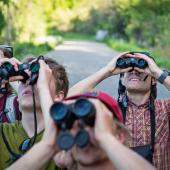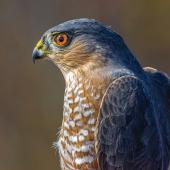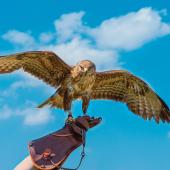Accidental Birding
Adding wildlife to the outdoor agenda.
Most folks don’t consider themselves “birders,” but who knows when you’ll be peeing in the forest and you get dive-bombed by an angry bird? Want to know what it is? Here are some birding basics.
Constantly observe. Sight and sound provide clues. When you see a bird, pay attention to shape, color, size, and behavior. The more you do this, the more you will see key features.
Carry compact versions of typical equipment. Smartphones can take pictures, record text and sound, and can download free bird guides (including calls). Compact binoculars can be inexpensive and quickly accessible. Keep the magnification at eight or below. This will make it easier to find the bird in your field of view. But the most basic is a pad and pen, and your own eyes and ears.
Think habitat. You’re likely to see a typical bird species in certain habitats. For example, clean rivers and streams have the American dipper—everyone around here should know this bird.
This summer, while you’re out hiking, biking, or fishing, follow the above tips and add birding to the itinerary. Here are some possible scenarios:
You’re biking a forest trail, come around a turn, and see a chicken-sized bird on the ground. Okay, it’s a grouse, but what kind of grouse? All are similar, so consider a field guide, but look at the head, neck, and “eyebrows.” Ruffed, spruce, and blue are all mountain grouse.
As you hike through a Douglas fir savannah, you see groups of little sparrow-sized birds fly ahead or from the ground to the trees. Often making an almost constant “tick” sound, the dark-eyed junco feeds on the ground, has a dark eye (duh!), a pale bill, and the head is darker than the rest of the body.
It’s mid-summer and you can finally bike the alpine ridges and meadows. Your gaze may drift skyward to larger birds of prey, but consider the little guys down lower. American pipits are ground-nesting alpine birds, and mountain bluebirds will be hunting insects.
While fly-casting along a stream you hear a “meew” sound, often mixed with a “chuk.” You see a bird that’s about the size of a slim robin, but dark gray and often in the brush. The gray catbird is common and gently vocal, and may also sing melodically.
You’re camped on one of our big rivers, the sun is low, and flying over the water is an obvious bird that flaps and glides, the long slim wings moving in an almost “bat-like” fashion, sporadically flapping with a quick downbeat. The bird zooms often and may make a “peent” like call. Seen close enough, you may see a little white bar on the wing, but the bird is not colorful at all. Common nighthawks are rarely seen when not flying, as they are cryptically colored, but the flight and sound are distinct. To see this bizarre bird perched would be a true, never expected, accidental sighting.
A longtime naturalist and guide, Ken Sinay owns Yellowstone Safari Company in Bozeman.















